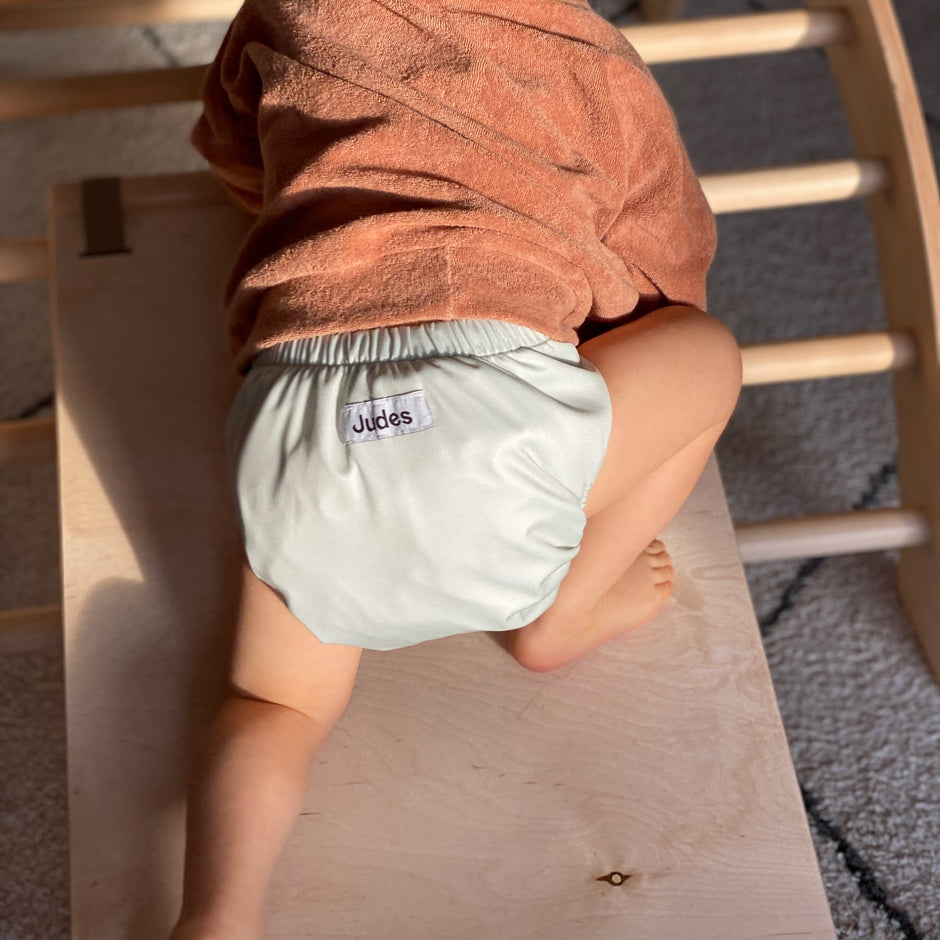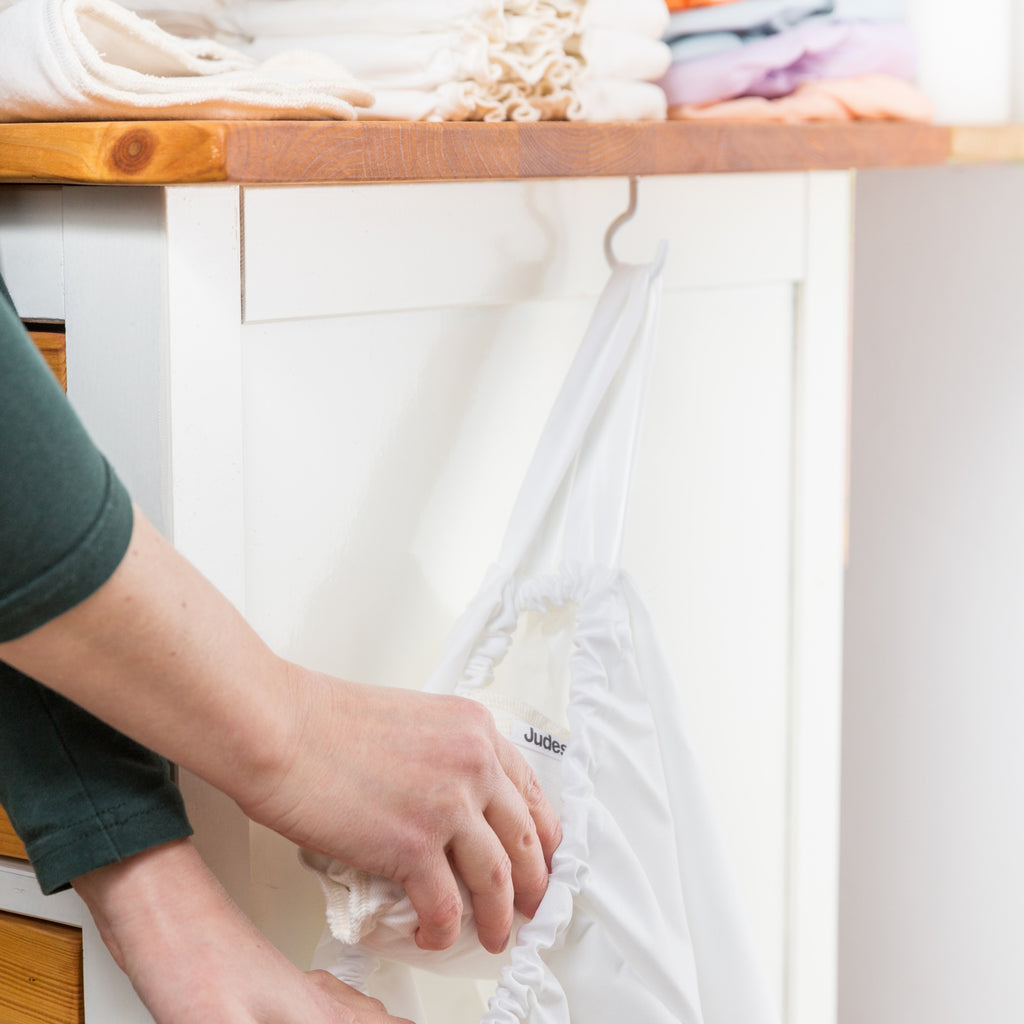The 13 Most Common Myths About Cloth Diapers That Don't Apply to Judes Family
Updated on:
Do you find the use of cloth diapers complicated and cumbersome? It was the same for me. I wasn't sure if I wanted to use cloth diapers, and my husband certainly wasn't keen either!
At some point, I came across Judes diapers. They looked very different from anything I had seen before. It wasn't so much about the colors or designs – it looked much simpler than I had expected.
Eventually, I managed to persuade my husband to try a sample pack. What can I say? The advertisement didn’t lie! It was incredibly simple and looked so much cuter than the old disposable diapers. I would never have thought about how much we'd save with Judes. But I’ll tell you more about that later.
Despite this, I still hear all the prejudices against cloth diapers everywhere. What lies behind these beliefs? I'll reveal it to you in this article. Spoiler alert: Cloth diapers are much better than you might think from these beliefs. I'll explain what's behind it.
So, here are the 13 most common beliefs that certainly do not apply to Judes:
- The washing effort is enormous
- Cloth diapers consist of many parts and are complicated to use
- It's super expensive, especially due to washing
- Cloth diapers don’t stay leak-proof
- They make a huge baby bottom
- It's unhygienic
- The partner doesn't cooperate
- Cloth diapers have a poor fit
- They are cumbersome on the go
- They are not so sustainable because of washing
- The wetness on the skin is unpleasant for the baby
- It causes diaper rash
- The daycare can't handle cloth diapers
1. The washing effort is enormous
What do I do with the full diapers? I can't just put them in the laundry basket. Then I'd have to constantly wash diapers to prevent them from lying around everywhere and starting to smell. Those were my thoughts. And how wrong I was. It's actually super easy and not cumbersome.
Disposable diapers take much less time, right?
Disposable diapers initially sound like they require little time. At least that's what one might think. You change your child and throw the diaper away. Done. But it's not quite that simple. You probably have to go out at least once a week to get new disposable diapers. That actually takes up a considerable amount of your time.
And even if you have a diaper subscription: even the package receipt and sorting takes time. You can actually measure it – for me, it was several minutes a week. And yes, we are only talking about minutes here. More on that shortly.
At the end of the day, you have a well-filled diaper pail next to your changing table. It now needs to be emptied. I have to go from my apartment on the third floor down to the basement. How about you? Regardless of how far your path to the trash is, it takes time each day.
With cloth diapers, you have little to no trash. Here, you only dispose of the Poo Paper along with the stool - even wipes can be replaced by sustainable washcloths. For me, it's currently always a small bag that we manage to fill within a day. When I think of the trash heaps we used to have here. Simply unbelievable!
This is how much time you need for washing Judes
My colleagues and I timed it. For our diaper laundry, we need an average of 15 minutes per week. What? Only that little? Yes, exactly!
- 0.5 min to load and start the washing machine
- 1 min to retrieve laundry from the machine
- 6 min to hang up laundry
- 1.5 min to take down and put away laundry
In total, I spent 9 minutes washing the diapers. I wash one and a half times a week. So I need 15 minutes per week for my diaper laundry. Of course, with a dryer, you're even faster.
How much time do you spend with disposable diapers? And even if it should be 5 minutes less, we ask ourselves: Is it worth it?
You can read about how to wash your cloth diapers gently and hygienically on our blog.

2. Cloth diapers consist of many parts and are complicated to use
I always thought cloth diapers consisted of many confusing parts, making their use incredibly complicated. My hasty research led me to exactly that conclusion: I would have to fold various cloths and place them in a cover—of course, considering the appropriate materials for the situation. That was too much effort for me. But then I saw Judes, and I realized: Cloth diapers can also be simple. But what makes Judes different? I’ll reveal it to you.
Cloth diapers consist of many confusing parts
As mentioned before, I hadn't researched cloth diapers too much. There was a reason for that. My research became very quickly complicated. Cloth diapers need many different inserts. I read about prefolds, muslin diapers, and fitted diapers, among others. There are day and night diapers and numerous different materials. During my research, many terms for various diaper systems appeared: All-in-One, pocket diapers, or All-in-Two, All-in-Three, or hybrid diapers. How was I ever supposed to get through that?
I was overwhelmed. Maybe you felt the same way. Naturally, the ads shown to me adapted to my interest in cloth diapers. I must say, luckily they did. Otherwise, I probably wouldn’t have found Judes.
What components do Judes have?
I watched an application video for Judes and thought: “Wow, it looks so incredibly simple. Actually just like disposable diapers, only prettier.” There is only an inner diaper and an outer cover. Both can be fastened seamlessly and very easily with Velcro. You don't have to get used to a new system.
My husband was just as surprised as I was that cloth diapers can be so easy. Even Grandma had a go at changing and just said: “This is just like a disposable diaper.” Well, only better, because I save waste, money, and it's healthy for my child. Of course, I'll also tell you how much money you can save.
If you want to know more about the differences between Judes and other cloth diaper systems, I can recommend the article by my colleague Franzi. She is a cloth diaper expert and has handled countless cloth diapers. She tells you in her experience report what makes Judes special.

3. It's super expensive, especially because of washing
You'd like to use cloth diapers but can't afford it? That's what I initially thought too. Have you ever calculated how much disposable diapers would cost you? I've done the math and I must say, I am shocked! I'd be happy to calculate it for you once.
What do disposable diapers cost?
Note! The following items have not been included in the calculation:
In our calculation, we did not account for the fact that Judes can be used for multiple children or resold secondhand (you can assume a resale value of about half the original price for Judes). We also did not include the societal costs of disposable diapers due to waste disposal (approx. 100€ per year – to be paid by the household) and environmental pollution (unknown costs).
-
0.27€ (Pampers)
-
0.34€ (Eco by Naty)
-
0.31€ (Lillydoo)
-
0.35€ (Lillydoo Green)
As of 06/05/22 at dm.
The average of these prices is 32 cents. We base the following on this diaper price.
Children should be changed every 2–3 hours, so we assume 7 diapers a day (in 24 hours). We also assume that children using disposable diapers need to be changed for an average of 3 long years.
From these assumptions, the following calculation results:
3 years x 365 days x 7 diapers at 0.32€ = 2,434€.
Additionally, the costs for a diaper pail (15 €), refill cartridges (approx. 67 € per year), wipes (approx. 98 € per year), and changing pads (approx. 17 € per year) need to be calculated. In our calculation, we assume that 9 wipes a day at 0.03 € (average price) are used. This brings us to 561€ in costs for disposable diaper accessories.
The costs from disposable diapers and accessories result in a total of 2,995€.
We also did a calculation with an extremely cheap disposable diaper variant:
Even if we assume the inexpensive Babylove diapers (dm store brand), according to the calculation above, we reach 996€. The costs for diaper accessories amounting to 561€ also apply here. In this extremely cheap case, we reach total costs of 1,557€.
What do cloth diapers cost?
With cloth diapers, you pay for the purchase once and then only for the washing. The purchase costs depend on your preferences and needs. On the Judes website, you can choose between different sets. The prices range in the mid-three-digit range and go up to a low four-digit range.
Thus, cloth diapers are definitely already below the price of disposable diapers. And if you're worried that it won't pay off for one child, I can reassure you. Perhaps you will even resell your cloth diapers once your child is potty-trained or use them for siblings.
What does washing cloth diapers cost?
Cloth diapers pay off with many children. We can surely agree on that. But is that also the case with just one child? After all, the washing costs are added. Doesn't it become more expensive with washing then? I can reassure you. Even if you only have one child, using cloth diapers is financially worthwhile.
A load of laundry at 60 °C requires less than 1 kWh of electricity, which costs about 30 cents on average. You can add another 30 cents for water usage and the cloth diaper detergent. This brings us to a price of 60 cents per wash cycle, as also indicated in public reports.
Is that not enough information for you? We've calculated it. By washing over three years, the following costs arise:
Electricity consumption: approx. 100€
Drinking and wastewater consumption: approx. 70€
Detergent: approx. 100€
This results in a total of 270€.
Washing incurs only a fraction of the costs that disposable diapers would cause. The more children use a cloth diaper, the more expensive the disposable diaper becomes in comparison.
And you have also prevented over a ton of plastic!

4. Cloth diapers don't stay leak-proof
Especially my husband believed that it could never work with cotton diapers. His belief: How is that little bit of fabric supposed to catch all the pee?
I thought it would work. After all, other parents also use cloth diapers. Besides, before disposable diapers, there were only cloth diapers. But nevertheless, I had doubts that cloth diapers would be as "good" as disposable diapers. I relied on the promise of Judes and I must say, they absolutely keep it!
With my daughter, the disposable diapers, depending on the model, really leaked often. My daughter occasionally opens her diapers herself. With disposable diapers, that's a disaster! Judes still stay leak-proof. It probably has to do with the two-part system. Because the outer cover doesn't have to fit very tightly to do its job. Judes really stay extremely leak-proof. Other customers also report this, as you can read in the reviews:
“The best cloth diapers!!! Super easy to put on, my child also finds Judes more comfortable than all other cloth diapers. They stay super leak-proof, I haven't had any leakage so far and we've been using Judes since birth. You can also wash the diapers well and they dry very quickly. A simple diaper system for every baby and also suitable for cloth diaper beginners.”
(Rebekka Weinrich)
“It is so easy that it's really fun! And unlike all tested disposable diapers, the diapers simply also stay leak-proof! Washing is no issue thanks to the super practical laundry bag, which actually makes the matter very odorless. All in all, a very clear recommendation!”
(Eva Schichl)
5. They make a huge baby bottom
With cloth diapers, you immediately think of the old days when children had a huge pile of fabric wrapped around their bottoms. Cloth diapers have fundamentally changed since then. Still, many cloth diaper models require thick inserts. These, in turn, lead to the huge baby bottom commonly associated with cloth diapers. Judes are different!
A special fabric is used for the Judes inner diaper. This contains up to 12 layers of extremely thin fabric, which is simultaneously very absorbent. Thus, the inner diapers are very thin yet have a high absorption capacity.
In comments about Judes, it is often mentioned that they create a slim bottom and children can wear their current sizes despite using cloth diapers. I can only confirm that. Indeed, my daughter still wears a smaller pair of pants than her bodysuits.
For us, nothing has changed in terms of clothing since we switched to cloth diapers. Well, sometimes I deliberately put an outer cover on her that matches her outfit. It just looks cuter then.

6. It's unhygienic
Why should cloth diapers be unhygienic? Ideally, a child should be changed immediately after doing their business, whether they're in a cloth or a disposable diaper. You're probably thinking more about the topic of washing.
Hygiene before washing with Judes
Problem number one: What about the stool? Judes offers a so-called Poo Paper to catch your child's stool. It is a diaper liner made of paper, with which you can easily lift and dispose of the stool from the diaper. So, you don't have to start scraping the stool out of the diaper.
Problem number two: Where to put the wet diaper? You probably don't want to place the full diaper with your normal 60°C laundry, just like I don't. For this, Judes provides the Wetbag, a large diaper sack that keeps odor and moisture inside. Here you can store not only the diapers but also your washcloths until the next 60°C wash is due.
How does washing Judes work?
I've already told you that you can store the full diapers in the Wetbag. In fact, this diaper sack can do even more. You don't need to take the diapers out anymore. On the contrary, the used diapers just stay inside.
You put the Wetbag with its contents into your washing machine and open the zipper at the bottom. This way, you don't come into contact with the used diapers again. The contents of the Wetbag are shaken out through the machine's spinning. In the end, everything gets clean. Sounds quite simple, right?
You probably still have one question on your mind. Does washing make them hygienically clean too? Yes, at 60°C everything becomes clean. Quite simple.

7. The Partner does not cooperate
As I mentioned at the beginning, my husband was not open to using cloth diapers. I've already shared some reasons with you, and I hope I was able to dispel them to your satisfaction.
How did I convince my husband of cloth diapers? It wasn't all that simple, but as you know, I managed to do it.
It is important to know what bothers your partner about cloth diapers. Perhaps some of the beliefs from this article are among them. Verifiable facts are always a good way to persuade. Videos and pictures can also be very helpful. Feel free to check out our Instagram account. Here you'll find useful videos and pictures, as well as tips and tricks for our cloth diapers.
Have you, like me, already successfully convinced someone? Share your story in the comments and help other parents with it.
8. They have a poor fit
This belief encompasses various prejudices against cloth diapers. They are said to leave strong marks, be uncomfortable, and restrict the baby's movement. I'll now tell you why Judes actually have a very good fit on your child's bottom.
They leave too strong marks
From my own experience, I can say that Judes leave hardly any or no marks at all. Of course, marks can occur if the diaper is unnecessarily closed too tightly. However, Judes remain leak-proof even with a loose fit. A guideline here is that two fingers can easily fit between the diaper and the belly.
Judes are continuously developed. Version 1.0 of the inner diaper did receive some critiques about leaving marks. That's why the cuffs have been made even softer. I myself use the 2.0 inner diapers and am very satisfied. Other customers write the same. Version 1.0 is no longer offered. This is a sign that Judes takes user feedback seriously and continuously improves the diapers.
Cloth diapers are uncomfortable
You think cloth diapers are uncomfortable? Believe me, once you've held a Judes inner diaper for the first time, you'll think differently. I was surprised myself at how soft Judes are. This soft feeling comes from the organic cotton that the inner diapers are made from. They are super gentle on the baby's bottom.
Cloth diapers mean movement restriction for the baby
If that were the case, I'd have less to do. But all jokes aside. Cloth diapers are designed, of course, to not restrict the baby's movement. Judes are kept as thin as possible. This further benefits freedom of movement.
Children in cloth diapers can move just as freely, learn to crawl, and walk as children in disposable diapers.

9. They are cumbersome on the go
Most people probably have this fear. How is it with disposable diapers? If you ask me, changing diapers on the go is never particularly easy. At home, you have a changing table, running water, all the clothes, diapers, and wipes you might need. On the go, you only have what's in your diaper bag, and depending on the surroundings, it can be more or less easy.
What needs to be included?
Where is the difference? Judes are as easy as disposable diapers in principle. You throw away the disposable diapers right in the trash after changing, provided you have a trash can nearby. Unfortunately, many people prefer to throw their used disposable diapers into nature if there is no trash can around. They don't want to carry the stinky diapers with them, because wow, a disposable diaper usually smells a lot.
You simply pack the used Judes back into the Wetbag and take them back home. You don't have to look for a trash can and the smell stays sealed. I found that the smell of full Judes is much more pleasant than that of used disposable diapers. I'm not sure exactly why this is. But the chemicals in disposable diapers could certainly be the reason.
An additional advantage over disposable diapers: the outer covers of Judes can even be used as a small changing pad. If you forget your changing pad, it's no problem at all. Often, cloth diapers also spark nice conversations with other people. Most people are very interested in the pretty alternative.

10. They aren't really sustainable because of washing
You can read in full how much more sustainable cloth diapers are compared to disposable diapers in my article on the sustainability of cloth diapers. So you don't have to read two articles at once, I'll disclose the key data regarding our belief here. However, the sustainability article is definitely recommended reading.
Water & energy consumption of disposable diapers
The Federal Environment Agency states that for disposable diapers, even without considering all production steps, there is already a water consumption of 202 L/kg. If you ask me, that sounds like a lot of water.
Regarding energy consumption, the Federal Environment Agency states 4.98 kWh per disposable diaper, of which 3.21 kWh are not derived from renewable energies. Is that a lot or not? It's best to compare it directly with cloth diapers.
Water & energy consumption of Judes
A study from the Environment Agency calculated an energy consumption of 1 kWh for a load of diapers at 60 °C with an energy efficiency class A+ machine. As the study is slightly older, it can be assumed that newer washing machines consume less than 1 kWh per wash cycle. The energy consumption is therefore significantly lower with cloth diapers than with disposable diapers.
Now I need to tell you how the water consumption looks for cloth diapers. The Environment Agency calculated in their study a consumption of 53L at energy efficiency class A for a wash load at 60 °C. I call that a stark difference compared to the 202 L/kg for disposable diapers! Cloth diapers also fare better here.
Are you wondering how the production of Judes affects water consumption? The Judes inner diapers weigh 100g each and are made of organic cotton. Assuming a water consumption of 243 L/kg for organic cotton, we would have a rainwater "consumption" of about 24.3 L per diaper, as reported by Vogue. The emphasis here is on rainwater. Disposable diapers usually use pumps for groundwater or treat water, which requires additional energy.

Photo by Casey Horner on Unsplash
11. The wetness on the skin is unpleasant for the baby
We imagine wearing a wet diaper to be uncomfortable. The advertising for disposable diapers drills exactly that into us. However, the advantages that this feeling of wetness brings are not mentioned in the ads. You're surely wondering what I'm talking about here. I'll tell you, but first about the disposable diapers.
Why is the feeling of wetness absent in disposable diapers?
Have you ever wondered what makes a full disposable diaper feel dry? The absorbent core of a disposable diaper consists of a so-called superabsorbent. This is a chemical substance, a polymer. It can absorb liquid and ensures that your baby still feels dry in the diaper even after many hours.
The feeling of wetness also brings advantages
With this title, you probably think I've gone crazy. But the fact that a baby feels the wetness on its body is indeed important. Important? For what? I'll give you a hint: it's something all parents look forward to. Exactly, I'm talking about potty training.
But do children with cloth diapers actually potty train faster? I would rather say, children with disposable diapers potty train more slowly. Unfortunately, disposable diapers can cause problems with potty training. The children cannot feel when they are wet because of the superabsorbent. Studies even show that longer wearing of disposable diapers is increasingly associated with enuresis (bedwetting beyond the age of 5).
You don't need to worry that your child will get cold because you don't have the immediate opportunity to change them. Everything in the diaper area is kept nice and warm by the child's own body heat. Only when you open the diaper does everything get cold.

Photo by Gabby Orcutt on Unsplash
12. It causes diaper rash
You think your child gets diaper rash from cloth diapers? I can tell you something. The opposite is true. Many babies get diaper rash from disposable diapers. Judes try to counteract this. Of course, I'll explain the reason for both.
Why disposable diapers often cause diaper rash
Earlier, I briefly mentioned the superabsorbent that absorbs your baby's pee. As you've surely noticed, this absorbent core is chemical. You can learn exactly what the superabsorbent consists of and why cloth diapers are more sustainable on our blog.
You can surely imagine that chemicals on a delicate baby's bottom can have negative effects. Furthermore, disposable diapers are mainly made of plastic. This plastic is also not beneficial to the baby's bottom. As a result, disposable diapers are not particularly breathable. All these factors contribute to or even cause diaper rash.
Why Judes can solve the problems of diaper rash
First and foremost, and in my opinion most importantly: Judes do not contain a chemical absorbent core! Everything that touches the baby's bottom is natural. The Poo Paper, which is directly against your child's bottom, is made of paper. The Judes inner diapers are made of organic cotton, which makes them very breathable. Judes customers also report that diaper rash does not occur with cloth diapers:
"We have been using Judes exclusively for 14 months and are still thrilled! Leaky diapers or sore skin areas are things we've only heard about. Super easy to use, there are no more excuses - nothing is complicated. An absolute must for every baby & toddler!"
(Alissa Stolle)
But secondly:
Have you ever noticed that nearly all parents who use disposable diapers apply ointment or moisturizing cream to their baby's skin? Honestly: I used to see it as a given, as if humanity had never done anything else. Now it seems almost absurd to me.
In fact, I have never had to use such a moisturizing cream. And the reason for that is simple: A baby's skin has the ability to regulate itself from birth! I suspect that is why Judes doesn't offer any rash ointments or moisturizing creams.
So, it's actually not Judes to thank for babies having healthy skin. Instead, it is due to the skin's own ability to regulate!

Photo by Sze Yin Chan on Unsplash
13. The daycare can't handle cloth diapers
An argument I've often heard is: "We can't handle the many different systems in the daycare routine." A reasonable objection. If all children had different cloth diaper systems, it would be a major challenge for the caregivers.
This applies, of course, to nannies and other caregiving options as well. However, many caregivers are ultimately very interested in Judes and appreciate the cloth diapers. Why? I'll tell you.
Since Judes work in principle just like disposable diapers, handling them is intuitive and simple. In fact, Judes even save waste and time for the caregivers. Less waste is generated because parents take the diapers back with them completely. This ensures that caregivers have less trash to deal with. It might seem like a drop in the ocean, but the more children switch to cloth diapers, the less waste is produced.
Our experiences show even more. Other cloth diaper systems involve significantly more effort, which takes the joy out of changing diapers for caregivers. When caregivers are shown how to handle Judes, they are delighted by the simplicity.
We've even heard more wonderful stories. Some parents have reported that the simplicity of Judes has quickly spread. Now, a large part of the parent community uses Judes for diapering.
What you should consider:
- Show the caregivers how to handle the cloth diapers.
- How many diapers does your child need in daycare? (This varies with the time spent there)
- Make sure there is a suitable Wetbag available in the daycare.
- Continue to communicate with the caregivers to work together on improvements in your approach.

Photo by Yuri Shirota on Unsplash
Conclusion: What is behind the beliefs?
Many beliefs are justified or at least once were. However, times have changed, just as cloth diapers have changed. Judes are proof of that.
Judes consist of fewer components than other cloth diaper systems. Their application is intuitive and therefore very simple. The purchase price initially seems high. However, when you calculate the cost of disposable diapers over the years, you end up with a higher amount (and yes, even when considering washing costs). With multiple children, the price of disposable diapers reaches a shocking level.
Judes stay leak-proof and do so very well. Customers report better leak protection than with disposable diapers. Despite the particularly thin fabric, Judes ensure a slim baby bottom. A larger clothing size is not necessary.
In terms of hygiene, Judes are also very simple. With Poo Paper, stool can be easily disposed of (like with disposable diapers, but without plastic waste). The Wetbag stores the diapers until washing and makes loading the washing machine unbelievably easy. At the right temperature (60 °C), the diapers are hygienically clean again.
You also don't have to worry about water and energy consumption. Here, disposable diapers fare much worse due to their production.
The washing effort is significantly less at 15 minutes than the time you spend buying disposable diapers and taking out the trash.
Are Judes cumbersome on the go? I don't think so. Quite the opposite! Disposable diapers require a trash can and stink to high heaven. With Judes, you don't have these problems, probably because they aren't composed of chemicals. Everything simply goes back into the Wetbag and remains odor-neutral.
The feeling of wetness in cloth diapers promotes a healthy potty training process. You also don't need to worry about diaper rash anymore. Because of all the chemicals in disposable diapers, diaper rash is encouraged. Judes are completely natural, with no chemicals touching the baby's bottom, allowing the skin to regulate itself.
Caregivers in daycares are generally very open to cloth diapers and appreciate the simple model of Judes diapers.
Surely you have encountered such beliefs in everyday life. Feel free to write in the comments what you've heard and how you dealt with it. This way, you can help others too.
Did you find the article helpful? I'm always open to your feedback.


